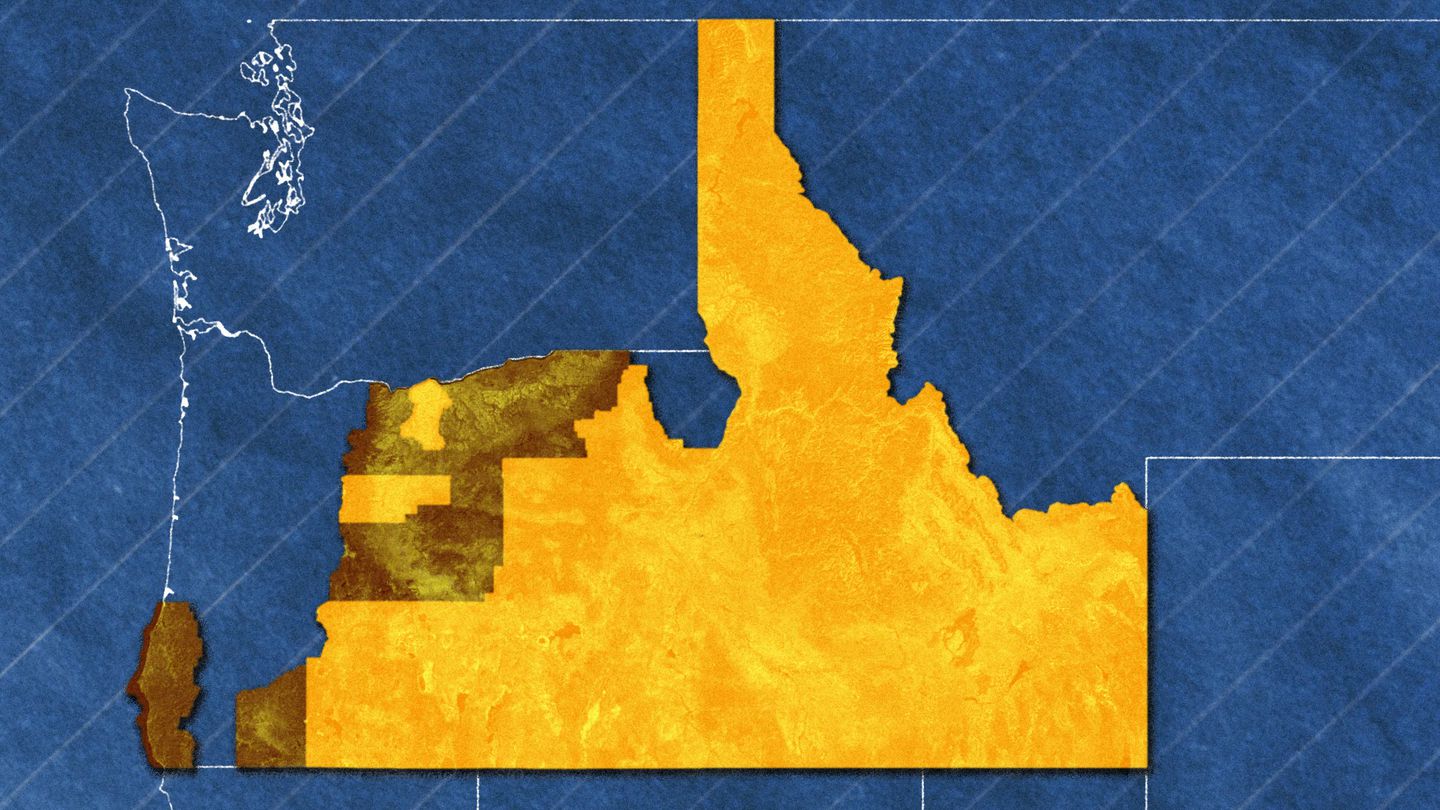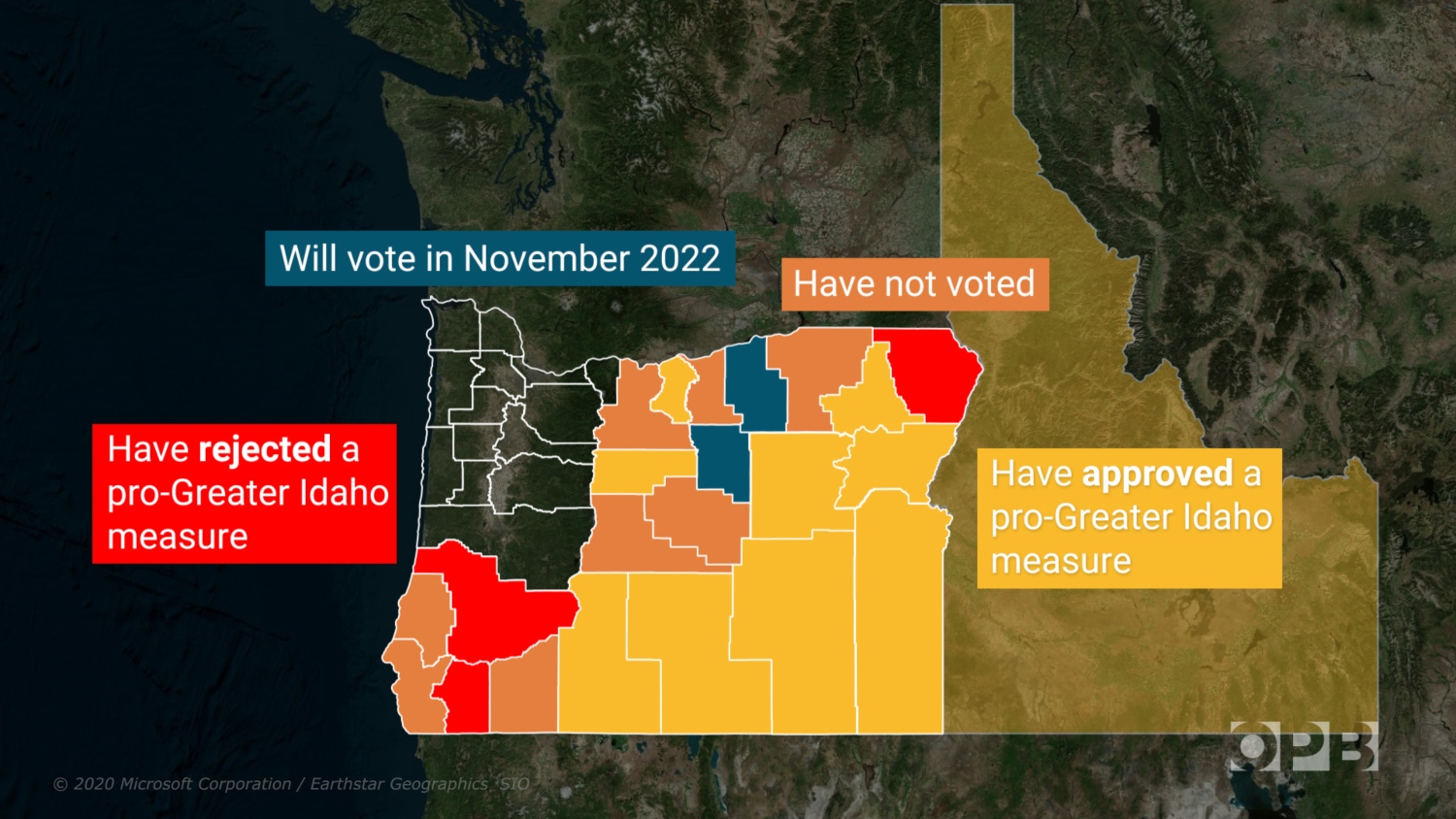Two more counties will vote on pro-Greater Idaho ballot measures as the movement looks to keep supporters engaged
By Antonio Sierra (OPB)
In the same place where thousands of voters once affirmed one of Greater Idaho’s first electoral victories, Mike McCarter wondered why more people weren’t continuing to show up to voice their support.
Two years ago, Union County voters approved a ballot measure that mandated the Union County Board of Commissioners meet the second Wednesday of every February, June and October to discuss only one topic: moving Union County from Oregon to Idaho.
More than 7,000 Union County voters approved the measure in the Nov. 3, 2020, election. By the time the commissioners convened on Oct. 12, it was their sixth meeting since the measure passed. McCarter, the president of Citizens of Greater Idaho, spoke to an in-person audience of about a half-dozen people.
“We’ve got a meeting going on this morning,” he said. “And you would think that if this is an important issue that the room would be packed. So there’s some resistance out there.”
McCarter and his group have spent the past several years backing ballot measures meant to build public support for an expanded, “greater” Idaho that would extend its western border to the Cascade Mountains. A divorce between rural Oregon and the Willamette Valley, the thinking goes, would allow Eastern Oregon and parts of central and Southern Oregon to align themselves with a state that shares much of rural Oregon’s conservative politics and culture.
Greater Idaho organizers say they are confident they can add two more Oregon counties to the group of nine counties that have already voted for pro-Greater Idaho measures. But supporters are reporting challenges in sustaining momentum from the movement and quiet resistance from Oregon government officials and voters.
Backing out at the ballot box
Redrawing Oregon and Idaho’s lines would require acts from both state legislatures plus congressional approval
But Citizens for Greater Idaho, and its predecessor group Move Oregon’s Borders, have pinned some of their hopes on county-wide advisory ballot measures. Greater Idaho expects to turn successful non-binding ballot measures into public pressure on the people who actually have the power to change state lines: lawmakers in Salem and Boise.
Greater Idaho secured its first wins in November 2020, when voters in Union and Jefferson counties approved local measures. Six more counties east of the Cascades followed in 2021, Klamath County joined the ranks in May, and the group is supporting two more measures in Morrow and Wheeler counties on the Nov. 8 ballot.
These local measures don’t bind counties to join Idaho, nor do they require a formal request to the Oregon Legislature to start the process. Most of the successful measures only require county governments to meet multiple times per year “to discuss how to promote the interest” of their county in border negotiations.
Greater Idaho spokesman Matt McCaw said the measures’ language was necessary to pass muster with state election rules.
“(Ballot language) has to be worded in a certain way. It has to create some new legislation,” he said. “In a lot of these counties, the only way to get a measure on the ballot was to couch it as, ‘Do you want your county court to meet to discuss this?’”
While Greater Idaho organizers were collecting signatures, they were also urging county commissioners to refer the issue to the local ballot themselves, a move McCaw said brought more flexibility in phrasing the question. But the results of the commissioner-referred measures were a lot more mixed.
On the same night, Greater Idaho claimed its first victories in 2020, it also experienced two losses.
Wallowa County voters rejected a boilerplate meeting mandate that would have required their board of commissioners to three times per year. But Douglas County residents voted against something very different.
The November 2020 measure simply asked voters if county commissioners and state legislators should “work toward moving the Idaho state border to include Douglas County?” On the night Donald Trump took two-thirds of Douglas County’s presidential votes, voters rejected the measure 57% to 43%.
Douglas County commissioners tried again in May, this time posing the question, “Shall county resources be used to incorporate Douglas County within Idaho State’s border and thereafter be subject to Idaho’s laws?” The measure fell again, this time by a tighter 53% to 47% vote.
Following the second vote in Douglas County and a failed attempt in neighboring Josephine County, Greater Idaho proponents pared back their ambitions. A rejiggered Idaho would no longer extend all the way to the Pacific Ocean through southwest Oregon and would instead stop at Klamath County.
Organizers still feel like the public sentiment is on their side within Eastern Oregon and the counties that have already passed measures. While the most successful version of the pro-Greater Idaho measure simply establishes a series of public meetings, McCaw said the organization still considers it a sign that the counties that have voted yes are ready for the move.
“When we talk to people, they understand that they’re voting on greater Idaho,” he said. “They’re voting on moving this process forward.”
‘Not going to stop’
Donna Beverage, the chair of the Union County Board of Commissioners, ran the Oct. 12 meeting more like a listening session than a planning meeting.
“The legislators are the ones that have the power in this,” she said. “And I believe our job is to listen to our constituents, which that’s what we’re doing.”
Grant Darrow, a Union County leader for Greater Idaho, was one of four people who attended the meeting to speak in favor of the concept. He echoed McCarter, the Greater Idaho president, in pointing out the struggles of keeping people engaged in the project.
Darrow said he formed a Union County-centric spin-off group, but despite building an email list of 33 people, he once held a meeting attended by only one person.
McCarter attributed this trend to a number of factors, including people being in “survival mode” during a period of inflation and rising fuel costs — and general voter apathy. A similar trend could also be felt a few hundred miles south in Lake County.
McCarter told the county commissioners that no Greater Idaho representatives were able to make it to a September meeting in Lake County. According to Lake County Board of Commissioner meeting minutes, the four attendees at that meeting were not pushing to join Idaho.
“The constituents in attendance were in consensus that they would rather have better representation than anything else,” meeting minutes from commissioner’s assistant Melanie Lasley state. “They have felt a lot of disrespect by people from the (Willamette) valley, and don’t agree with a lot of the political decisions that have been made. There is fear that Eastern Oregonians will not want to separate from the social service programs and higher minimum wage that Oregon offers.”
The potential challenges of switching states were brought up multiple times in La Grande, including questions about how to balance Idaho and Oregon’s different policies on issues such as water rights, land use laws and cannabis.
McCarter said all those issues could be sorted out in state-level negotiations, but he had trouble getting Eastern Oregon legislators to push for the idea while they waited to see how the current election cycle.
Greater Idaho has gotten further with the Idaho Legislature. In 2021, an Idaho Senate committee hosted a hearing on the proposal. But the reaction from Idaho legislators was mixed, with some senators having the same questions Oregon officials did about the differences in policies.
Union County isn’t receiving much guidance from Idaho either. Commissioner Paul Anderes said he sent a letter to Idaho Gov. Brad Little four times to get his thoughts on the matter and has yet to hear back.
Greater Idaho also isn’t finding much solace in a potential Christine Drazan governorship. At an Oregon Newspaper Publishers Association forum in August, the Republican candidate for Oregon governor echoed many of Greater Idaho’s talking points before pivoting to the need to create a “unified Oregon.”
“There is a lack of understanding from Salem about what it really means to live in the rural parts of the state,” she said. “And a lot of the proposals that are rammed down their throats are not workable, not welcome, and nobody in Salem has been accommodating enough to recognize that we need to be a unified Oregon.”
McCarter was skeptical of this approach.
“There’s a desire to bring both sides back together,” he said. “I don’t know how that’s going to work. It hasn’t happened in the past with it.”
Back in La Grande, Union County commissioners occasionally chimed in with their own logistical questions for McCarter. Commissioner Matt Scarfo asked how long before Greater Idaho achieved its goal.
McCarter said he couldn’t provide a timeline, but he did promise that Greater Idaho would continue its mission of adjoining rural Oregon to Idaho beyond ballot measures.
“I don’t know what’s going to come up in front of us,” he said. “But I can tell you that the greater Idaho movement is not going to stop. We’re not giving up. Even when we run out of counties, and we’ve got all the county votes and everything else.”




